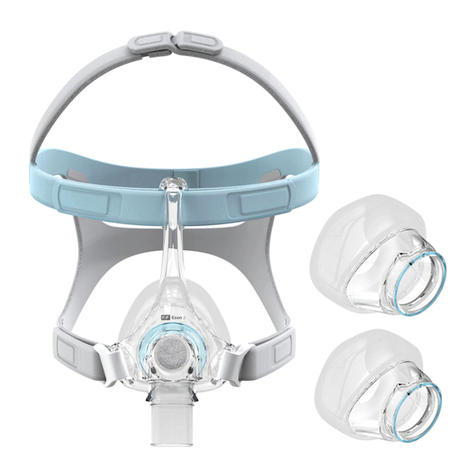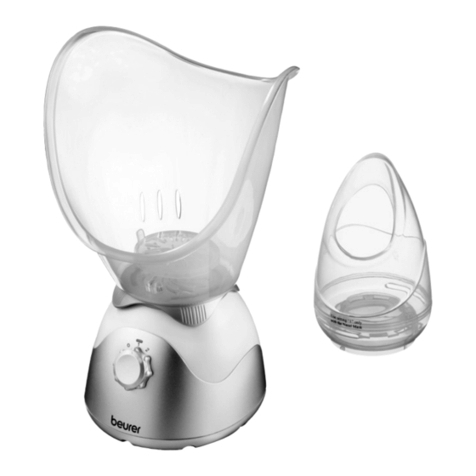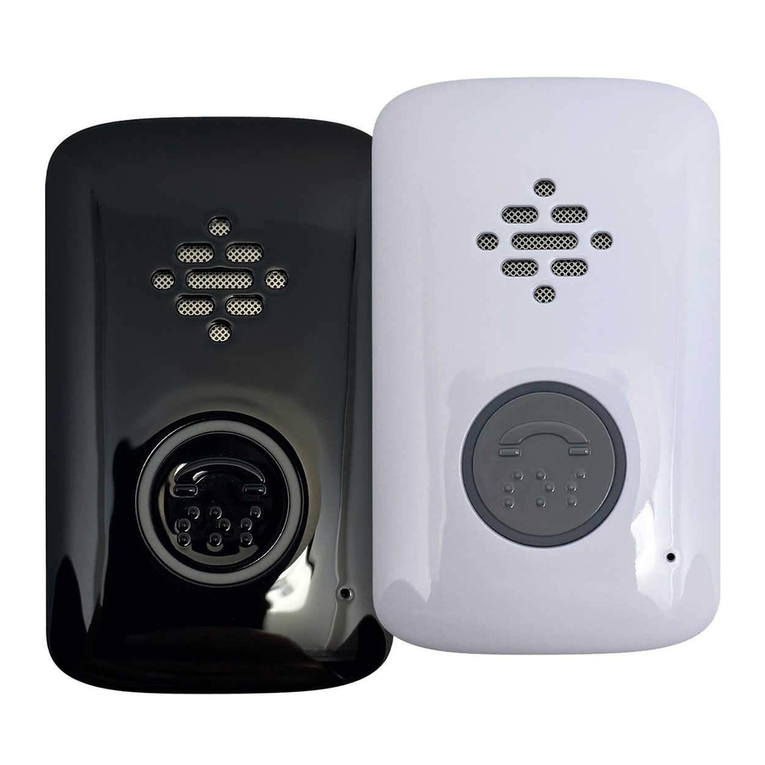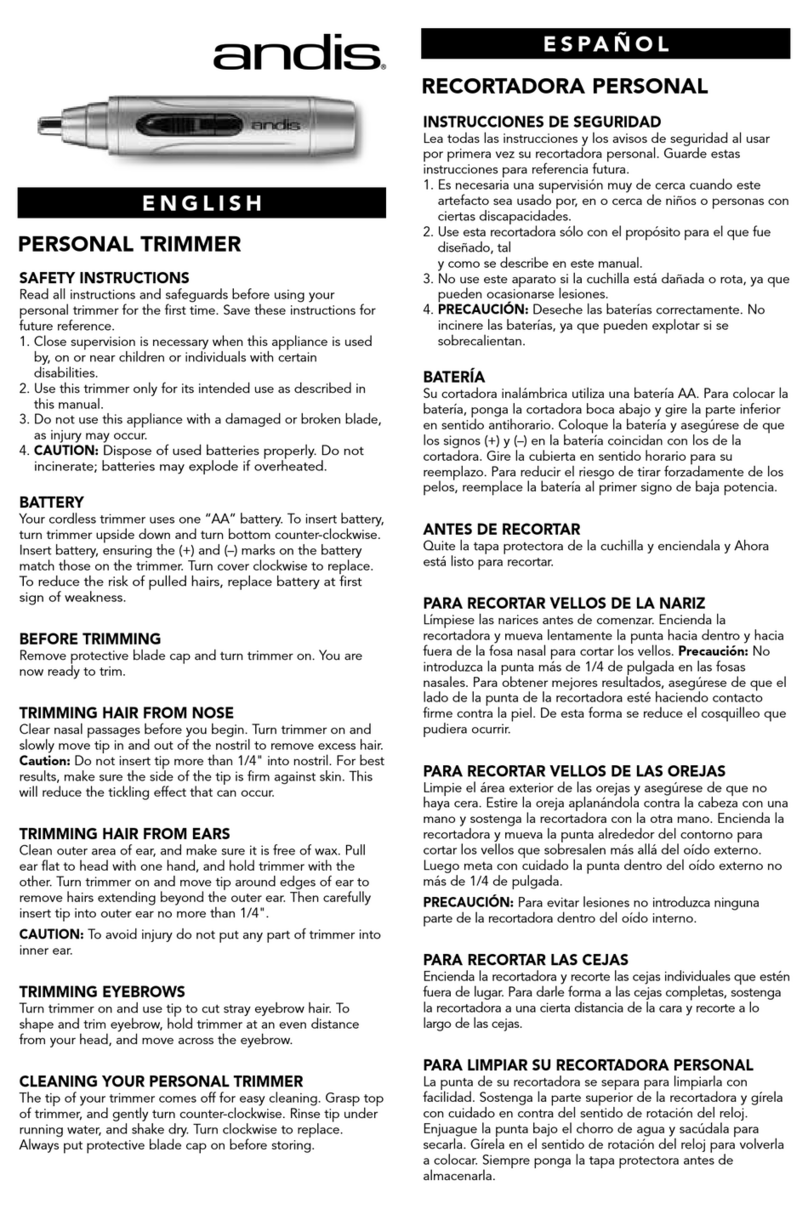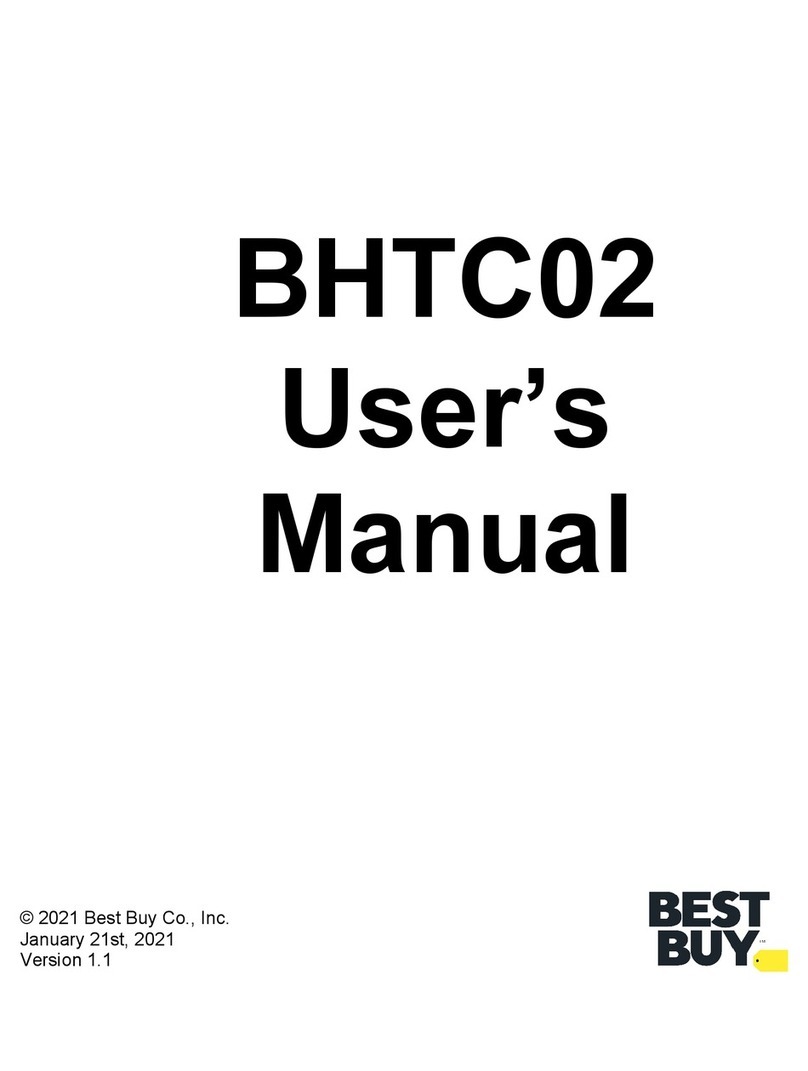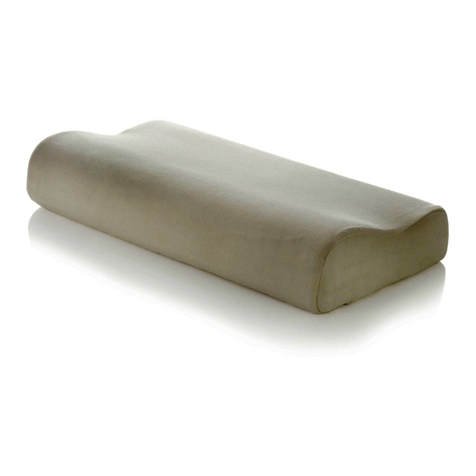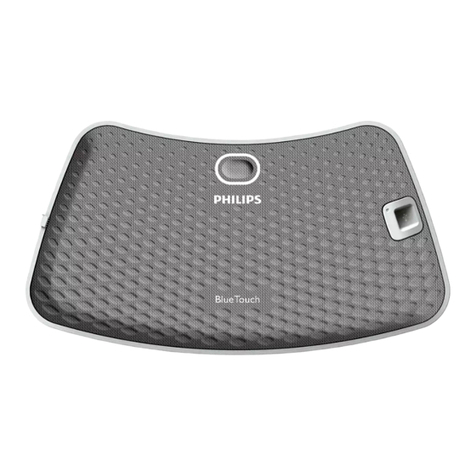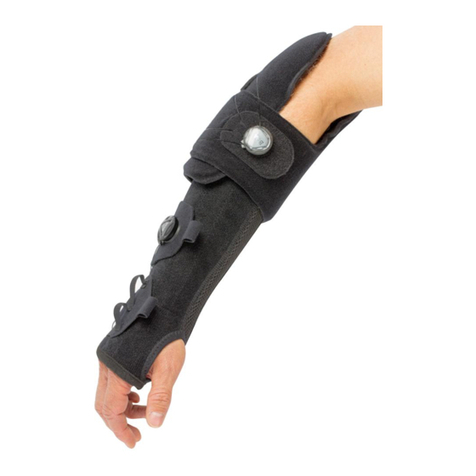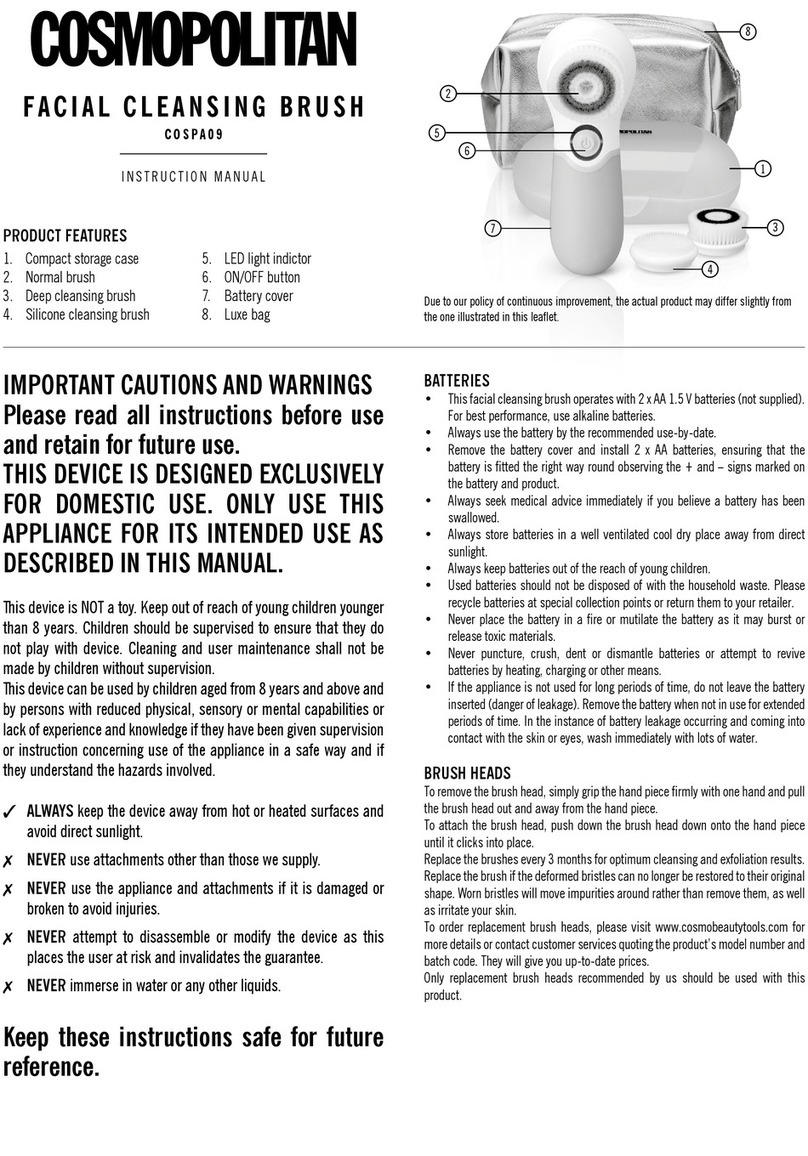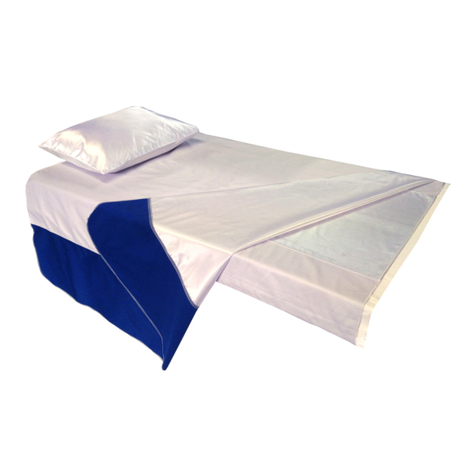Tecsana EPI-NO Delphine + Biofeedback User manual

1
All manuals and user guides at all-guides.com

2
Instructions For Use 3 - 13
Gebrauchsanweisung 14 - 23
Mode d`Emploi 24 - 33
Istru ioni per l´Uso 34 - 43
Instrucciones de Uso 44 - 53
English
Deutsch
Français
Italiano
Español
www.epino.com
TECSANA GmbH
Planegger Straße 9a
D-81241 München
Tel +49 (0) 89 / 74 11 43 - 0
Fax +49 (0) 89 / 74 11 43 - 15
All manuals and user guides at all-guides.com

3
Product Description
The EPI·NO Delphine and the Delphine
Plus Birth and Postnatal Trainer were de-
signed, developed and manufactured in
Germany in close co-operation with
gynaecologists, midwives and pregnant
women.
It consists of (1 a narrow contoured silicone
balloon, (2 a hand pump, (3 a mirror
(EPI·NO Delphine or a pressure display
(EPI·NO Delphine Plus , (4 an air release
valve, (5 connected by a flexible plastic
tube.
Indication
EPI·NO Delphine and Delphine Plus are
patented and intended to be used as a
Birth Trainer and a Pelvic Floor Muscle
Trainer.
Applications
First, EPI·NO Delphine and Delphine
Plus can gently prepare your perineum for
childbirth:
Birth Preparation
Second, EPI·NO Delphine Plus exercises
promote optimal postnatal recovery:
Pelvic Floor Muscle Training
Training methods
Three Stage Birth Program
(EPI·NO Delphine and Delphine Plus
·Exercise the Pelvic Floor Muscles
To strengthen the pelvic floor muscles be-
fore birth.
·Stretch the Perineum
For the gradual stretching of the vaginal
passage, the perineum and the vaginal
muscles prior to birth.
·Prepare for the Birth
To train for the delivery phase of child-
birth.
Postnatal Pelvic Floor Muscle
Training Program
( Note: Only EPI·NO Delphine Plus offers
biofeedback
Pelvic Floor Muscle Training
To strengthen the pelvic floor muscles fol-
lowing birth.
English
EPI·NO Delphine
EPI·NO Delphine Plus
All manuals and user guides at all-guides.com

4
All exercises are simple and can be done
on your own in the privacy of your home.
You can adjust EPI·NO Delphine and
Delphine Plus training to your specific re-
quirements.
Clinical studies and practical experience
have shown the effectiveness of choosing
an EPI·NO Delphine or Delphine Plus
training regimen.
During the stretching exercises for birth
preparation, the pressure display ( only
EPI·NO Delphine Plus does not indi
cate the balloon size.
You can determine your training progress
with the measurement template included,
or use a tape measure ( A measurement
of the balloon size is possible only outside
the body .
However, during pelvic floor muscle train-
ing, your exercise progress is indicated by
the movement of the pressure display
needle ( only EPI·NO Delphine Plus .
If a caesarean section is planned you will
not benefit from perineal stretching, how-
ever EPI·NO may still be used to ensure
effective pelvic floor muscle training.
Contraindications
You must not use EPI·NO Delphine and
Delphine Plus if any of the following are
present:
·The baby is in an unusual position, or if
there are identified risks making a
vaginal birth impossible ( e.g. Placenta
praevia .
·There is a risk of an ascending infection
(e.g. premature amniorrhexis, infection
of the vagina
·You have injuries in your genital area
which have not yet healed.
·You are under the influence of alcohol or
drugs.
·You have vaginal bleeding.
·You have a malignant desease in your
genital area (e.g. cervical cancer
EPI·NO Delphine and Delphine Plus
should only be used under the supervision
of a physician or midwife:
·If you have any nerve damage or other
diseases that reduce pain sensation in
your genital area.
·If you are a paraplegic
·If you have been diagnosed with Multiple
Sclerosis.
·If pain killers that reduce the feeling of
pain in the vaginal area have been ad-
ministered .
·If you have marked varicosity at the
vaginal entrance (varicose veins .
Please consult your physician or midwife
before using EPI·NO Delphine or
Delphine Plus.
English
All manuals and user guides at all-guides.com

5
Warning / Caution
·For hygenic reasons, EPI·NO Delphine
and Delphine Plus are intended as
single user devices; meaning only one
woman should use the device.
·Childbirth training should not begin more
than three weeks before the expected
delivery date or as established by your
physician or midwife.
·Do not use EPI·NO Delphine or
Delphine Plus for more than two preg-
nancies, or after the end of its recom-
mended life span ( as shown on the label
on the hand pump .
·Stop exercising with EPI·NO Delphine
or Delphine Plus if you experience any
pain.
·Before you use EPI·NO Delphine or
Delphine Plus for the first time or if it has
not been used for more than four weeks,
you should inflate the balloon by first
closing the air release valve, then
squeezing the hand pump about ten
times in sequence.
Open the air release valve to let the air
out and return the balloon to its original
shape. This allows you to test the device.
If your EPI·NO Delphine or Delphine
Plus is not in perfect working order con-
tact your supplier before use.
·We recommend you thoroughly wash
your hands with soap and water before
each use of EPI·NO Delphine or
Delphine Plus . Please strictly observe
the guidelines for cleaning and disinfect-
ing EPI·NO Delphine and Delphine
Plus ( see section Cleaning and Disin-
fecting .
·Only use water-based lubricants.
Do not use lubricants containing oils or
essential components as these can
damage the balloon.
·Take care not to damage the balloon
with pointy or sharp-edged items (e.g.
rings, fingernails, etc. .
·When the balloon is inserted and inflated,
you should not move excessively to avoid
uncontrolled movements of the balloon.
·EPI·NO Delphine or Delphine Plus
must not be used under water ( e.g. in
the bath as penetrating water can im-
pair function.
·Store EPI·NO Delphine and Delphine
Plus carefully to avoid extended expo-
sure to direct sunlight.
·EPI·NO Delphine and Delphine Plus
should be kept out of reach of children!
EPI·NO-Birth Preparation
EPI·NO Delphine and Delphine Plus Birth
Trainer are designed to be used by
English
All manuals and user guides at all-guides.com

6
both primiparae, (mothers expecting their
first child , as well as by multiparae, where
no medical reasons make its use inappro-
priate ( see section on Contraindications .
If your physician or your midwife, has not
recommended a specific training regimen,
you should begin EPI·NO Delphine or
Delphine Plus training 3 weeks before
your expected delivery date.
Through the gradual strengthening and
stretching of the muscles and tissue, the
entire pelvic floor will become stronger and
more elastic.
This reduces the chance of a tear of the
perineum or the need for an episiotomy
during delivery.
If the perineum remains undamaged, the
muscles and tissue can more easily re-
cover following childbirth. Furthermore, any
unpleasant after-effects, such as scars,
prolapse or incontinence may be avoided.
Instructions
Select a pleasant place for your exercise
with EPI·NO Delphine or Delphine Plus .
Ensure you are not disturbed. Choose a
comfortable position ( e.g. semi reclined .
With time and practice you will find the most
appropriate position for you.
Under some circumstances you may also
discover a suitable position for giving birth
to your child.
Close the air release valve before introduc-
ing the balloon into the vagina. In some
cases it may be necessary to lubricate the
tip of the balloon ( see section Warning /
Caution .
Three Stage Birth Program
1 Exercise the Pelvic Floor Muscles
Insert about two thirds of the balloon into
the vagina ( see illustration . By gently glid-
ing the balloon up and down you will ob-
tain a feeling of the elasticity within the
perineal area. Remain relaxed during your
exercises even if the training is unfamiliar
at the beginning.
Experience has shown that a certain rou-
tine is achieved after about three training
sessions. You will develop a feeling for the
best routine for you.
While tensing the pelvic floor muscles try
to draw the balloon upward for about 10
seconds. Then relax for 10 seconds and
repeat this exercise for a minimum of 10
minutes. Gently touch the balloon and feel
it moving upwards with the muscle tension.
This way you can check that you are exer-
cising correctly.
EPI·NO Delphine Plus Only: Observe the
needle on the pressure display before and
after tensing the pelvic floor muscles. You
may not notice any appreciable pressure
difference when you first commence your
exercises. However, after a few days you
will begin to achieve your first results.
English
All manuals and user guides at all-guides.com

7
2 Stretch the Perineum
Slowly inflate the balloon, as far as your
personal comfort level permits ( a slight
stinging sensation indicates stretch . Leave
the inflated balloon in the vagina for a pe-
riod of about ten minutes.
With this exercise the skin and muscles, the
perineal area, as well as the birth canal
are gradually and gently expanded.
The balloon size should be increased
gradually from one training session to the
next. However, you should always stay
within your personal comfort level.
By operating the air release valve you can
reduce the balloon size at any time. The
reading on the pressure display ( only
EPI·NO Delphine Plus does not indicate
the balloon size.
Do not rely on the pressure readings on
the pressure display in this training phase
- simply trust your body feeling.
3 Prepare for Birth
At the end of the stretch, relax your pelvic
floor muscles and allow the balloon to gen-
tly expel itself from the vagina. This simu-
lation of birth allows you to experience the
sensation of birth ahead of time.
You can determine your training progress
with the measurement template included,
or use a tape measure ( A measurement
of the balloon size is possible only outside
the body .
Further Information
Sometimes the pelvic floor tension may be
intensified when letting the balloon glide
out. In the first training session we recom-
mend you reduce the size of the balloon
by letting a little air out to become familiar
with this exercise.
As your training progresses you will find it
easier to let the balloon glide out. Gradu-
ally increase the balloon diameter, build-
ing your confidence and strength.
Each session should not last longer than
30 minutes and not be performed more
than twice a day.
Clean your EPI·NO Delphine and
Delphine Plus according to the method
described ( see section on Cleaning and
Disinfecting at the end of each training
session.
Each training session reduces the risk of
damage to your perineum during child-
birth. Optimum training is achieved when
the balloon has reached a diameter of 8-
10 cm ( 3-4 inches and can be glided out
while inflated after about two weeks of
training.
Once you have reached a balloon diam-
eter of 8-10 cm ( 3-4 inches you should
then focus on training the pelvic floor and
practising for the delivery phase.
It is not recommended, to further increase
the balloon size. A diameter of 10 cm ( 4
inches represents the approximate space
needed for delivering your baby.
English
All manuals and user guides at all-guides.com

8
Occasionally the balloon may be expelled
prematurely ( e.g. because of excess lubri-
cant . Avoid this by holding it in place or
closing your legs.
You can also feed the balloon in slightly
further. Even if the balloon slips totally into
the vagina and touches the cervix, it can
be returned to the correct position by pull-
ing slightly at the base of the balloon.
If any complications should arise when
using the EPI·NO Delphine or Delphine
Plus please consult your physician or mid-
wife immediately.
Postnatal Pelvic Floor
Muscle Training Program
( Note: Only EPI·NO Delphine Plus offers
biofeedback
Before commencing EPI·NO Delphine
Plus postnatal pelvic floor muscle training
any vaginal discharge should have sub-
sided and any perineal injuries allowed to
heal.
We recommend using EPI·NO Delphine
Plus not before 3 weeks after your delivery.
We also recommend the exercises should
continue for a minimum of 3 weeks ( usu-
ally postnatal training extends for 4 to 6
months .
T pical s mptoms of weakened
pelvic floor muscles are:
·Leaking of urine when coughing, sneez-
ing, climbing stairs, and carrying heavy
objects.
·Constant urge to urinate, even with an
empty bladder.
·A strong feeling of downward pressure.
·Prolapse of the vaginal tissues or the
uterus.
·Involuntary loss of wind ( flatus and stool
( anal incontinence .
Select a pleasant place for your exercise
with EPI·NO Delphine Plus. Ensure you
are not disturbed.
Choose a comfortable position ( e.g. semi
reclined . With time and practice you will
find the most appropriate position for you.
Take relaxed, regular breaths during ex-
ercise. Try to relax your buttocks, thighs and
stomach. We recommend exercising 10 to
20 minutes per day.
Getting Started
Open the air release valve, squeeze the air
out of the balloon with your hand, then
close the air release valve. The balloon will
now remain in this deflated shape. Lubri-
cating the top half of the balloon will facili-
tate insertion ( see section Warning / Cau-
tion .
Hold the balloon near the end and intro-
duce it about two thirds of the way into the
Pelvic floor muscles (red)
English
All manuals and user guides at all-guides.com

9
vagina. Take your time, as the vagina may
be dry and tender.
Relax your pelvic floor. Now inflate the bal-
loon to the point that you are aware of its
presence ( for most women the pressure
gauge will show 2 . Should the pressure
be too strong, you can reduce it at any time
by opening the air release valve.
Perineal Draw Up Exercise
While tensing the pelvic floor muscles try
to draw the balloon upward for about 10
seconds. Then relax for 10 seconds and
repeat this exercise again.
Gently touch the balloon and feel it mov-
ing upwards with the muscle tension. This
way you can check that you are exercising
correctly.
EPI·NO Delphine Plus only: Observe the
needle on the pressure display before and
after tensing the pelvic floor muscles:
See Training Progress Table.
You may not notice any appreciable pres-
sure difference when you first commence
your exercises. However, after a few days
you will begin to achieve your first results.
Further exercises with EPI·NO
Delphine Plus
The following exercises give you a variety
of training possibilities. Follow the instruc-
tions for use or train with the EPI·NO
Delphine Plus exercises recommended
by your physician or midwife.
Follow the instructions for inserting your
EPI·NO Delphine Plus ( see section Post-
natal Pelvic Floor Muscle Training Pro-
gram .
During all exercises you can follow the
needle on the pressure display and check
your pelvic floor strength.
Pressure difference Comment
( tensed - relaxed )
< 1 Should be improved
1 - 2 You are getting there
3 4 Already very good
> 4 Ex ellent
Training Progress Table:
English
Pelvis Rock
Lie on your back and bend your knees with
your feet firmly on the ground, and pres-
sure on your heels. Alternately raise your
right and left hip and repeat this 2-3 times.
Around the Clock
Assume the same starting position as for
Pelvis Rock. Imagine there is a clock un-
der your pelvis. Follow the movement of the
hands, first clockwise and then counter
clockwise. The movements should be so
smooth that the pelvis seems to continu-
ously rotate.
All manuals and user guides at all-guides.com

10
Long Legs
Lie on your back and stretch your legs. The
entire spinal column should touch the floor.
Move your chin towards your chest so that
the neck is stretched.
Alternately push your right and left heel
away as if you want to elongate your legs.
Simultaneously draw your toes towards
your body.
Cleaning and Disinfecting
Caution
·Make sure the pump does not get wet
during cleaning and disinfecting be-
cause water may damage the interior.
·Follow cleaning and disinfecting instruc-
tions prior to first use and immediately
after every subsequent use.
·If EPI·NO Delphine or Delphine Plus
is not used for more than 7 days, repeat
cleaning and disinfecting prior to use.
Before first usage and immediately after
every use, clean EPI·NO Delphine or
Delphine Plus thoroughly following these
guidelines:
·Inflate the balloon by pressing the pump
about 10 times.
·Carefully clean the balloon with soap
and warm water ( minimum 40°C /
104°F; 1-2 minutes . Take care not to wet
the pump as water may damage the in-
terior. Rinse the balloon under warm run-
ning water. Let EPI·NO Delphine or
Delphine Plus dry on a clean, smooth
surface.
·Disinfect EPI·NO Delphine or Delphine
Plus by wiping it with 70% Isopropyl from
your pharmacy. Use a cotton pad or
medical alcohol pads like those supplied
in your starter set.
·Only when completely dry place EPI·NO
Delphine or Delphine Plus into the
pouch, close zip and store in a clean, dry
place.
We wish you success with your EPI·NO
Delphine or Delphine Plus training.
English
All manuals and user guides at all-guides.com

11
English
( Example )
Æ = 7 cm
0 cm 1 2 3 4 5 6 7 8 9 10
Measurement Template
ÆC
Diameter Cir umferen e
in m in m
5,0 ®16
5,5 ®17
6,0 ®19
6,5 ®20
7,0 ®22
7,5 ®24
8,0 ®25
8,5 ®27
9,0 ®28
9,5 ®30
10,0 ®31
To mesaure the diameter of the inflated
balloon, align the balloon with the solid line
( 0 cm on the left of the template card as
shown in the diagram.
The horizontal red arrows ( example 7 cm
indicate the widest point of the balloon.
The Conversion Table opposite indicates
the Circumference value for each Dia-
meter measurement.
All manuals and user guides at all-guides.com

12
English
To mesaure the diameter of the inflated
balloon, align the balloon with the solid line
( 0 inches on the left of the template card
as shown in the diagram.
The horizontal red arrows ( example 2.8
inches indicate the widest point of the
balloon.
The Conversion Table opposite indicates
the Circumference value for each Dia-
meter measurement.
( Example )
Æ = 2.8 inches
00.20.40.60.81 0 1.2 1.4 1.6 1.8 2 0 2.2 2.4 2.6 2.8 3 0 3.2 3.4 3.6 3.8 4 0
inches
Measurement Template
ÆC
Diameter Cir umferen e
in in hes in in hes
2.0 ®6.3
2.2 ®6.9
2.4 ®7.5
2.6 ®8.2
2.8 ®8.8
3.0 ®9.4
3.2 ®10.0
3.4 ®10.7
3.6 ®11.3
3.8 ®11.9
4.0 ®12.6
All manuals and user guides at all-guides.com

13
All manuals and user guides at all-guides.com

14
Produktbeschreibung
Die Beckenbodentrainer zur Geburtsvor-
bereitung und Rückbildung EPI·NO Del
phine und Delphine Plus wurden in en-
ger Zusammenarbeit mit Gynäkologen,
Hebammen und Schwangeren mit größ-
ter Sorgfalt entwickelt.
Sie bestehen aus (1 einem anatomisch
geformten aufblasbaren Silikonballon, (2
einer Handpumpe, (3 einem Spiegel
(EPI·NO Delphine oder einer Druckan-
zeige ( Delphine Plus , (4 einem
Luftablassventil sowie (5 einem Zu-
führungsschlauch.
Indikation
EPI·NO Delphine und Delphine Plus sind
als Beckenbodentrainer zur Geburtsvor-
bereitung und Rückbildung patentiert. Mit
EPI·NO Delphine und Delphine Plus
erschliessen sich Ihnen zwei Anwendungs-
gebiete mit verschiedenen Übungs-
möglichkeiten.
Anwendungsgebiete
Erstens, mit EPI·NO Delphine und Del
phine Plus können Sie ihren Beckenboden
schonend auf die Geburt vorbereiten:
Geburtsvorbereitung
Zweitens, mit den EPI·NO Delphine Plus
Übungen unterstützen Sie optimal die
nachgeburtliche Regeneration:
Beckenbodentraining
Übungen mit EPI·NO
Drei Stufen Geburtsvorbereitungs-
programm
(EPI·NO Delphine und Delphine Plus
·Beckenbodenübungen
Zur Stärkung der Beckenboden-
muskulatur vor der Geburt.
·Dehnungsübungen
Zur schrittweisen Dehnung des Schei-
denausgangs, des Damms und der
Vaginalmuskulatur vor der Geburt.
·Simulationsübungen
Zum Einüben der Austreibungsperiode.
Nachgeburtliches Beckenboden-
training
( Hinweis: Nur EPI·NO Delphine Plus bie-
tet Biofeedback
Deutsch
EPI·NO Delphine
EPI·NO Delphine Plus
All manuals and user guides at all-guides.com

15
Beckenbodenübungen
Zur Stärkung der Beckenbodenmuskulatur
nach der Geburt.
und nachgeburtlichen Beckenboden-
übungen mit EPI·NO Delphine oder Del
phine Plus sind jedoch in jedem Fall hilf-
reich.
Gegenan eigen
EPI·NO Delphine und Delphine Plus
dürfen Sie nicht anwenden:
·Bei ungewöhnlicher Lage des Kindes
bzw. bei Befundrisiken, die eine vagina-
le Entbindung unmöglich machen ( z.B.
Placenta praevia .
·Bei Gefahr einer Infektion durch aufstei-
gende Keime ( z.B. vorzeitiger Blasen-
sprung, Scheideninfektion
·Bei nicht abgeheilten Verletzungen im
Genitalbereich.
·Unter Einfluss von Alkohol oder Drogen.
·Bei vaginalen Blutungen.
·Bei bösartigen Erkrankungen im Genital-
bereich (z.B. Gebärmutterhalskrebs
Nur unter Aufsicht eines Arztes oder einer
Hebamme dürfen Frauen EPI·NO Delphi
ne und Delphine Plus anwenden:
·Bei Nervenschädigungen und anderen,
das Schmerzempfinden im Genital-
bereich einschränkenden Erkrankungen
·Bei Querschnittslähmung.
·Bei Multipler Sklerose.
·Bei Einnahme von Schmerzmitteln, die
das Schmerzempfinden im Genital-
bereich einschränken.
·Bei ausgeprägter Venenerweiterung am
Scheideneingang ( Krampfadern .
Deutsch
Alle Übungen können Sie zu Hause und
ohne fremde Hilfe ausführen und das Trai-
ning ganz auf Ihre persönlichen Bedürfnis-
se abstimmen.
Klinische Studien sowie unzählige Erfah-
rungsberichte von Anwenderinnen haben
die Wirksamkeit des Trainings mit EPI·NO
Delphine und Delphine Plus eindrucks-
voll bestätigt.
Bei den Dehnungsübungen zur Geburts-
vorbereitung zeigt der Druckanzeiger
( nur EPI·NO Delphine Plus nicht den
Ballonumfang an. Ihren Trainingsfort-
schritt stellen Sie vielmehr anhand der rück-
seitig abgebildeten Schablone oder mit ei-
nem Maßband fest.
Beim Beckenbodentraining hingegen, zeigt
sich der Trainingserfolg durch den Aus-
schlag des Druckanzeigers ( nur EPI·NO
Delphine Plus , dessen Wert Sie einfach
ablesen können.
Wenn bei Ihnen eine Kaiserschnittgeburt
geplant ist, sind die Dehnungsübungen zur
Geburtsvorbereitung nicht sinnvoll. Die vor
All manuals and user guides at all-guides.com

16
Bitte sprechen Sie vor der Anwendung von
EPI·NO Delphine oder Delphine Plus
mit Ihrem Arzt oder Ihrer Hebamme.
Sicherheitshinweise
·Um eine Verschleppung von Keimen
auszuschliessen, dürfen EPI·NO Del
phine und Delphine Plus nur von ei-
ner Frau angewendet werden.
·EPI·NO Delphine und Delphine Plus
frühestens drei Wochen vor dem errech-
neten Geburtstermin anwenden, oder
wie mit Ihrem Arzt oder Hebamme be-
sprochen.
·EPI·NO Delphine und Delphine Plus
nicht bei mehr als zwei Schwangerschaf-
ten und nicht nach Ablauf des Haltbar-
keitsdatums einsetzen.
·Beenden Sie die Übungen mit EPI·NO
Delphine und Delphine Plus, wenn Sie
dabei Schmerzen verspüren.
·Vor der ersten Anwendung oder nach
einerAnwendungspause von mehr als
vier Wochen, sollten Sie den Ballon , nach
dem Schliessen der Luftablassschraube,
durch ca. zehnmaliges Zusammen-
drücken des Handballs, aufblasen.
Öffnen Sie nun die Luftablassschraube,
um den Ballon wieder in seine Ausgangs-
form zu bringen.
So können Sie das Gerät auf Unversehrt-
heit prüfen und sich mit dem Umgang
von EPI·NO vertraut machen. Sollte das
Gerät Beschädigungen aufweisen, ist von
einer Anwendung abzusehen.
·Wir empfehlen, die Hände vor jedem
Gebrauch von EPI·NO Delphine und
Delphine Plus gründlich mit Wasser
und Seife zu waschen.
Halten Sie sich bei der Reinigung und
Desinfektion von EPI·NO Delphine und
Delphine Plus an die Empfehlungen
( siehe Abschnitt Reinigung und Desin-
fektion .
·Verwenden Sie auschließlich Gleitmittel
auf Wasserbasis.
Verwenden Sie keine Gleitmittel die Öle
oder ätherische Zusätze enthalten, da
diese den Ballon schädigen können.
·Achten Sie darauf, dass der Ballon nicht
durch spitze oder scharfkantige
Gegenstände (z.B. Ringe, Fingernägel etc.
beschädigt wird.
·Mit eingeführten und gleichzeitig auf-
gedehnten Ballon, sollten Sie Lage-
änderungen nur sehr behutsam durch-
führen oder vermeiden, um keine un-
kontrollierten Ballonbewegungen aus-
zulösen.
·EPI·NO Delphine oder Delphine Plus
darf nicht unter Wasser angewendet
werden ( z.B. in der Badewanne , da ein-
dringendes Wasser die Funktionsfähig-
keit des Geräts beeinträchtigen kann.
·EPI·NO Delphine oder Delphine Plus
sollten so gelagert werden, dass eine
längere direkte Sonneneinstrahlung ver-
mieden wird.
·EPI·NO Delphine oder Delphine Plus
unzugänglich für Kinder aufbewahren !
Deutsch
All manuals and user guides at all-guides.com

17
Geburtsvorbereitung mit
EPI·NO
EPI·NO Delphine oder Delphine Plus
können Sie, sofern nicht medizinische
Gründe dagegen sprechen ( siehe Ab-
schnitt Gegenanzeigen , sowohl bei Ihrer
ersten als auch bei weiteren Schwanger-
schaften anwenden.
Sofern Ihnen Ihr Arzt oder Ihre Hebamme
die Anwendung nicht anders empfohlen
hat, sollten Sie mit den Übungen 3 Wochen
vor dem errechneten Geburtstermin begin-
nen.
Durch das schrittweise Dehnen und Stär-
ken der Muskulatur und des Gewebes wird
der gesamte Beckenbodenbereich ge-
stärkt und elastischer.
Somit wird die Wahrscheinlichkeit deutlich
verringert, dass es während der Geburt
zum Dammriss kommt oder dass ein
Dammschnitt erforderlich wird.
Bleibt der Damm unverletzt, bedeutet dies
für die Zeit nach der Entbindung, dass sich
Muskeln und Gewebe leichter und dauer-
hafter regenerieren können. Zudem kön-
nen Sie so äusserst unangenehme Nach-
folgebeschwerden wie Narben, Senkun-
gen oder Inkontinenz vermeiden.
Anwendungshinweise
Wählen Sie für Ihre Übungen mit EPI·NO
Delphine oder Delphine Plus einen für
Sie angenehmen Platz und gönnen Sie sich
für jede Trainingseinheit ca. 30 Minuten
Ruhe und Entspannung. Sorgen Sie dafür
dass Sie nicht gestört werden. Nehmen Sie
zu Trainingsbeginn eine bequeme Haltung
ein (z.B. liegend mit aufgerichtetem Ober-
körper .
Im Laufe der Zeit werden Sie durch Aus-
probieren die für Sie angenehmste Körper-
haltung beim Training herausfinden. Da-
bei können Sie unter Umständen schon
eine für Sie geeignete Geburtsposition ken-
nenlernen.
Bevor Sie den Ballon einführen, schliessen
Sie bitte die Luftablassschraube. In vielen
Fällen kann das Benetzen des Ballons mit
einem Gleitmittel ( maximal bis zur Taille
die Einführung erleichtern ( siehe Abschnitt
Sicherheitshinweise .
Drei Stufen Geburtsvorbereitungs-
programm
1 Beckenbodenübungen
Fassen Sie nun den Ballon am Schlauch-
ansatz an und führen sie ihn zu etwa zwei
Drittel in die Scheide ein ( siehe Abbildung .
Durch leichte Auf- und Abbewegungen des
Ballons bekommen Sie ein Gefühl für die
Dehnbarkeit im Dammbereich. Bleiben Sie
bei den Übungen locker, auch wenn das
Training am Anfang noch ungewohnt ist.
Die Erfahrung zeigt, dass sich nach etwa
drei Übungseinheiten eine gewisse Routi-
ne einstellt und Sie ein Gefühl für die für
Sie optimale Anwendung entwickeln.
Versuchen Sie nun, den Ballon für ca. 10
Sekunden durch ein Anspannen der
Deutsch
All manuals and user guides at all-guides.com

18
Beckenbodenmuskulatur nach oben zu
ziehen. Entspannen Sie anschliessend Ihre
Muskulatur für 10 Sekunden und wieder-
holen Sie diese Übung.
Diese gesamte Übungseinheit führen Sie
bitte mehrfach über einen Zeitraum von
mindestens 10 Minuten aus.
Berühren Sie leicht den Ballon und spüren
Sie, wie er sich durch die Muskelanspan-
nung nach oben bewegt. Dadurch haben
Sie die Gewissheit, dass Sie die Übungen
korrekt ausführen.
Nur EPI·NO Delphine Plus:
Beobachten Sie während dieser Übung
den Zeigerausschlag auf der Druckan-
zeige vor und nach dem Anspannen der
Beckenbodenmuskulatur. Bei den ersten
Anwendungen werden Sie vielleicht noch
keinen Ausschlag feststellen.
Bereits nach wenigen Tagen werden sie
jedoch erste Erfolge verzeichnen und Ihre
Fortschritte durch den Zeigerauschlag be-
stätigt sehen.
2 Dehnungsübungen
Pumpen Sie den Ballon langsam so weit
wie möglich auf, ganz wie es Ihr persönli-
ches Empfinden zulässt ( ein leicht ziehen-
des Gefühl zeigt Ihnen die Dehnung an .
Belassen Sie den Ballon für etwa eine bis
10 Minuten in der Scheide.
Durch diese Übung werden Haut und
Muskulatur im Dammbereich sowie der
Geburtskanal langsam und vorsichtig er-
weitert.
Die im Training maximal erreichte Ballon-
grösse sollte schrittweise von Trainings-
einheit zu Trainingseinheit gesteigert wer-
den.
Bleiben Sie aber immer unterhalb Ih
rer persönlichen Schmerzgrenze.
Durch Betätigen der Luftablassschraube
können Sie die Ballongrösse jederzeit wie-
der reduzieren. Der auf der Druckanzeige
( nur EPI·NO Delphine Plus angezeigte
Wert ist kein Maß für den Ballondurch-
messer. Lassen Sie sich durch die Werte auf
der Druckanzeige in dieser Übungsphase
nicht irritieren und vertrauen Sie auf Ihr
Körpergefühl.
Deutsch
3 Simulationsübungen
Versuchen Sie am Ende der Dehnungs-
phase den Ballon durch Lockerlassen der
Beckenbodenmuskulatur hinausgleiten zu
lassen.
Ihren Trainingsfortschritt stellen Sie anhand
beiliegender Durchmesserschablone oder
mit einem Maßband fest ( Eine Bestim-
mung der Ballongrösse ist nur ausserhalb
des Körpers möglich .
Weitere Hinweise
Das Dehngefühl wird beim Hinausgleiten
des Ballons verstärkt und kann unange-
nehm sein. Deshalb empfehlen wir bei den
ersten Übungen, den Ballonumfang durch
kurzes Öffnen der Luftablassschraube et-
was zu reduzieren.
All manuals and user guides at all-guides.com

19
Im weiteren Verlauf der Übungen wird Ih-
nen das Hinausgleiten des Ballons ent-
sprechend des Trainingsfortschritts leichter
fallen.
Eine Übungseinheit sollte nicht länger als
30 Minuten dauern und in der Regel nicht
öfter als zweimal am Tag durchgeführt
werden.
Reinigen Sie nach jeder Trainingseinheit Ihr
EPI·NO Delphine oder Delphine Plus
nach den beschriebenen Verfahren ( sie-
he Abschnitt Reinigung und Desinfektion .
Mit jeder Übungseinheit reduzieren Sie das
Risiko einer Dammverletzung. Ideal ist es,
wenn Sie nach etwa zwei Wochen Training
in der Lage sind , den auf einen Durchmes-
ser von ca. 8-10 cm aufgepumpten Ballon
aus der Scheide hinausgleiten zu lassen.
Wenn Sie durch die Dehnungsübung einen
Ballondurchmesser von ca. 8-10 cm er-
reicht haben, dies entspricht ungefähr dem
Platzbedarf des kindlichen Kopfes in sei-
ner Geburtsposition, legen Sie von nun an
den Schwerpunkt auf die Beckenboden
und Simulationsübungen.
Eine weitere Steigerung der Ballongrösse
ist nicht sinnvoll und nicht zu empfehlen.
Gelegentlich kommt es vor, dass der Bal-
lon zu stark nach aussen drängt ( z.B. durch
Verwendung von zuviel Gleitgel . Dem
können Sie durch leichtes Gegenhalten mit
der Hand bzw. einem leichten Schliessen
der Beine entgegenwirken.
Sie können aber auch nach eigenem Emp-
finden den Ballon etwas tiefer einführen.
Selbst wenn der Ballon ganz in die Schei-
de rutscht und dabei den Muttermund be-
rühren sollte, können Sie ihn durch leich-
tes Ziehen am Schlauchansatz wieder in
die richtige Position bringen.
Sollte es bei den Anwendungen von
EPI·NO Delphine oder Delphine Plus zu
Komplikationen kommen, so suchen Sie
bitte umgehend Ihren Arzt oder Ihre Heb-
amme auf.
Nachgeburtliches
Beckenbodentraining
( Nur EPI·NO Delphine Plus bietet Ihnen
Biofeedback
Wenn Sie das Beckenbodentraining mit
EPI·NO Delphine und Delphine Plus zur
nachgeburtlichen Regeneration einsetzen
wollen, beginnen Sie frühestens drei Wo-
chen nach der Geburt mit dem Training.
Der Wochenfluss sollte abgeklungen, even-
tuelle Verletzungen im Intimbereich verheilt
sein. Wir empfehlen darüber hinaus das
Training mindestens über einen Zeitraum
von 3 Wochen durchzuführen.
( Üblicherweise wird ein Rückbildungs-
training bis zu einer Dauer von vier bis
sechs Monaten nach der Geburt durchge-
führt .
Beckenbodenmuskulatur (rot)
Deutsch
All manuals and user guides at all-guides.com

20
Typische Symptome einer geschwäch
ten Beckenbodenmuskulatur sind:
·Unkontrollierter Harnabgang ( Harn-
inkontinenz beim Husten, Niesen,
Treppensteigen und Tragen schwerer
Gegenstände.
·Ständiger Harndrang, auch bei schwach
gefüllter Blase.
·Starkes, nach unten gerichtetes Druck-
gefühl.
·Vorfall der Scheidenmuskulatur oder der
Gebärmutter.
·Unkontrollierter Abgang von Winden
( Windinkontinenz und Stuhl ( Stuhl-
inkontinenz .
Wählen Sie für die Übungen mit EPI·NO
Delphine und Delphine Plus einen für Sie
angenehmen Platz. Sorgen Sie dafür das
Sie nicht gestört werden.
Nehmen Sie zu Trainingsbeginn eine be-
queme Haltung ein ( z.B. liegend mit aufge-
richtetem Oberkörper . Im Laufe der Zeit
werden Sie durch Ausprobieren die für sich
angenehmste Körperhaltung für das Trai-
ning herausfinden.
Atmen Sie bei den Übungen ruhig und
gleichmäßig. Versuchen Sie die Muskulatur
von Bauch, Gesäß und Oberschenkel zu
entspannen.
Versuchen Sie pro Tag 10 bis 20 Minuten zu
trainieren.
Vorbereitungen
Öffnen Sie die Luftablassschraube und neh-
men Sie den Ballon in Ihre Hand. Bilden Sie
eine Faust um den Ballon zusammenzudrük-
ken.
Schliessen Sie dann die Luftablassschrau-
be, damit sich der Ballon nicht mehr entfal-
ten kann. Anschliessend können Sie Ihre
Hand wieder öffnen. Der Ballon bleibt nun
in seiner schmalen Form erhalten.
In vielen Fällen kann das Benetzen der
oberen Hälfte des Ballons mit einem
Gleitmittel die Einführung erleichtern ( sie-
he Abschnitt Sicherheitshinweise .
Fassen Sie nun den Ballon am Schlauchan-
satz an und führen ihn zu etwa zwei Drittel
in die Scheide ein. Lassen Sie sich Zeit, die
Scheide kann trocken und empfindlich sein.
Entspannen Sie Ihre Beckenbodenmus-
kulatur. Pumpen Sie nun den Ballon auf, bis
Sie ihn spüren ( bei den meisten Frauen zeigt
die Druckanzeige bei EPI·NO Delphine
Plus nun den Wert 2 an .
Der Ballon entfaltet sich dabei. Sollte der
Druck zu hoch sein, können Sie diesen je-
derzeit durch Betätigen der Luftablass-
schraube wieder verringern.
Beckenbodenaufzugsübung
Versuchen Sie den Ballon für ca. 10 Sekun-
den durch ein Anspannen der Becken-
bodenmuskulatur nach oben zu ziehen.
Entspannen Sie anschliessend Ihre Mus-
kulatur für 10 Sekunden und wiederholen
Sie diese Übung.
Berühren Sie leicht den Ballon und spüren
Sie, wie er sich durch die Muskelanspan-
nung nach oben bewegt.
So stellen Sie sicher, dass Sie nicht nur die
äusseren Muskelschichten trainieren, son-
dern auch die Darunterliegenden mit ein-
bezogen werden.
Deutsch
All manuals and user guides at all-guides.com
This manual suits for next models
1
Table of contents
Languages:


